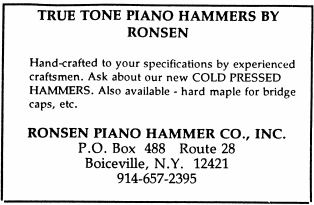|
Tech Tip
by Michael Slavin, Chapter President The cardboard used in the United States Postal Service priority mailers, and well as FedEx envelopes, is a great material to cut into strips for shimming balance rails. It is a perfect thickness to achieve the desirable lift, and remains very stable under variable humidity conditions. |

|
by Allan Schumacker - Secretary
A meeting of the Long Island Nassau Chapter, PTG was held on March 8, 2011, at Frank and Camille’s Keyboard Center located on Old Country Road in Carle Place. Seven chapter members and three guests attended.
President Slavin called the meeting to order at 6:50 P.M. Minutes for last month’s meeting were accepted by general consent. A treasurer’s report was not given.
President Slavin made the following announcements:
Mike Collins from Wessel, Nickel, and Gross will be our guest speaker next month. The presentation will be about their carbon-fiber action parts.
The Mid-Atlantic Regional Convention will be held in Bethlehem, Pennsylvania, April 28-May 1.
Chapter membership remains unchanged since last year.
The business meeting ended at 6:55 P.M. and the guest speaker for the evening, Arlan Harris, was introduced. An RPT, Mr. Harris is a member of the New York City Chapter. The presentation for the evening was titled: “The Modern Concert Piano Technician: ‘Techniques, Concepts, and Tips for Stable Piano Tuning.’”
Mr. Harris distributed a two-page handout, stating that his presentation would be fast-paced, and not all topics on the handout would be covered due to insufficient time. The focus of the lecture would be primarily on concert tuning. Mention was made how the pianist is dependent on the tuner-technician to get the piano ready for the concert. In addition to the pianist’s needs, the tuner-technician’s needs also come into consideration. Whether one stands or is seated, head position, body position, height of the piano bench, physical characteristics, and a variety of tuning techniques, all influence the quality and stability of the tuning. Brief mention was made of the Alexander Technique for reducing body tension.
Mr. Harris continued his lecture, demonstrating techniques for speed tuning and tuning stability. Other topics discussed and demonstrated included string seating; bridge-pin seating; changing the horizontal or vertical position of individual aliquots, when possible, as a means to influence the quality of the piano’s tone; and insertion of a brass rod between the tuning pins and the capo d’astro bar in octaves five and six, to increase bearing in that section of the piano. Some tips on voicing were also shared with the group. At the conclusion of the lecture, Mr. Harris answered questions from members of the audience.
The meeting ended at 8:00 P.M. Mr. Harris was thanked for his excellent presentation.
Respectfully submitted,
Allan N. Schumacker, RPT